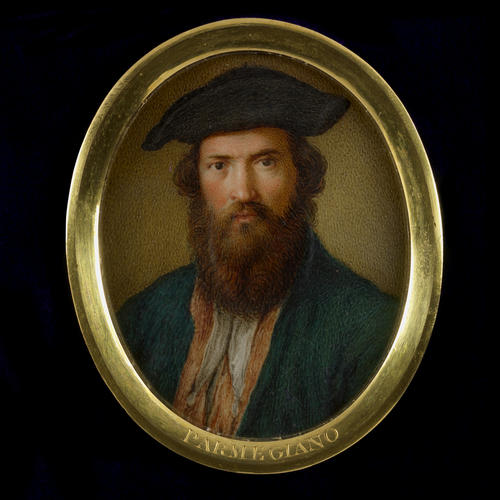-
1 of 253523 objects
Parmigianino (1503-1540) c.1773-80
Watercolour on ivory | 6.4 x 5.2 cm (sight) (sight) | RCIN 421183
-
Francesco Mazzola, called Parmigianino was an Italian painter, draughtsman and printmaker from Parma. He was highly talented – aged 16 he painted a Baptism (1519, Berlin, Gemäldergalerie), revealing his study of Correggio, and in 1522-3 he painted frescoes in S. Giovanni Evangelista in Parma. In 1524, Parmigianino moved to Rome, possibly via Florence, where he was influenced by the work of Michelangelo and Raphael. Giorgio Vasari, the artist and biographer, said of his Self-Portrait in a Convex Mirror (1524, Vienna, Kunsthistorisches Museum) which the artist presented to Pope Clement VII, that he looked 'so beautiful that he seemed an angel rather than a man'. When Rome was sacked in 1527, he moved to Bologna, then in 1530 went back to Parma to paint frescoes for S. Maria della Steccata. He failed to complete the work, however, and was imprisoned for breach of contract. According to Vasari, Parmigianino became fascinated with alchemy and 'allowed his beard to grow long and disordered … he neglected himself and grew melancholy and eccentric'. His last work, unfinished at his death, was the Madonna of the Long Neck (Florence, Uffizi). As well as religious paintings, Parmigianino painted portraits and mythological subjects, and made designs for engravings and woodcuts. Two of his paintings are in the Royal Collection (RCIN 406025 and RCIN 405765) as well as a number of his drawings.
This miniature is one of the collection of copies of 224 self-portraits by artists in the Uffizi Palace, Florence, that Lord Cowper, the art collector and patron, commissioned Giuseppe Macpherson (1726-1780) to paint. He presented the miniatures to King George III in two batches, in 1773 and 1786. Macpherson followed the original self-portraits quite closely, but copied only the head and shoulders. He inscribed the artists' names on the backs of the miniatures – several differ from those in the modern Uffizi catalogue, notably: Bazzi, Bellini, Campi, Annibale Carracci, Gabbiani, Masaccio, Metsys, Moroni, Pencz, Licinio, Schiavone and Spada. None of the miniatures is signed, apart from Macpherson's own self-portrait, which is inscribed: Giuseppe Macpherson / Autore della serie (Giuseppe Macpherson / Author of the series).Macpherson was born in Florence, the son of Donald Macpherson, a footman in the service of Alexander, 2nd Duke of Gordon. He was a pupil of Pompeo Batoni and painted miniatures and enamel portraits in Italy, France and Germany, finally settling in Florence. A James Macpherson is recorded in London and Paris in 1754 but it is not certain that this is the same person. He was described in 1776 as having a special talent for painting on enamel and as being 'almost the only painter in Europe who possesses this art to perfection'. He had a distinguished client list which included some of the crowned heads and dignitaries of Europe. In 1778, he was invited to add his own self-portrait to the famous painters in the grand duke's collection as it 'would do honour to Florence to enrich the collection with a work which shows that we still have some men of true merit' according to Giuseppe Pelli, director of the Uffizi at the time.
Provenance
Presented to George III by Lord Cowper
-
Creator(s)
Acquirer(s)
-
Medium and techniques
Watercolour on ivory
Measurements
6.4 x 5.2 cm (sight) (sight)
Other number(s)
RL 02.9/1
